Air con Citroen BERLINGO MULTISPACE 2015 2.G User Guide
[x] Cancel search | Manufacturer: CITROEN, Model Year: 2015, Model line: BERLINGO MULTISPACE, Model: Citroen BERLINGO MULTISPACE 2015 2.GPages: 298, PDF Size: 12.69 MB
Page 16 of 298
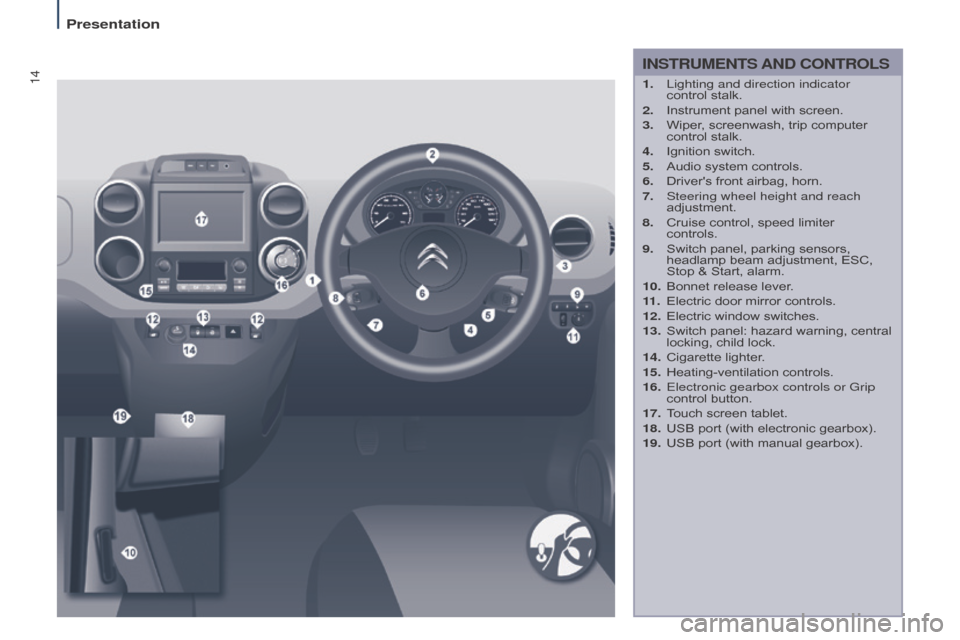
14
Berlingo-2-VP_en_Chap01_vue-ensemble_ed01-2015
INSTRUMENTS AND CONTROLS
1. Lighting and direction indicator
control stalk.
2.
Instrument
panel with screen.
3.
Wiper
, screenwash, trip computer
control
stalk.
4.
Ignition
switch.
5.
Audio
system controls.
6.
Driver's
front airbag, horn.
7.
Steering wheel height and reach
adjustment.
8.
Cruise
control, speed limiter
controls.
9.
Switch
panel, parking sensors,
headlamp
beam adjustment, ESC,
Stop
& Start, alarm.
10.
Bonnet
release lever.
11 .
Electric
door mirror controls.
12.
Electric
window switches.
13.
Switch
panel: hazard warning, central
locking,
child lock.
14.
Cigarette
lighter.
15.
Heating-ventilation
controls.
16.
Electronic gearbox controls or Grip
control
button.
17.
T
ouch screen tablet.
18.
USB
port (with electronic gearbox).
19.
USB
port (with manual gearbox).
Presentation
Page 18 of 298
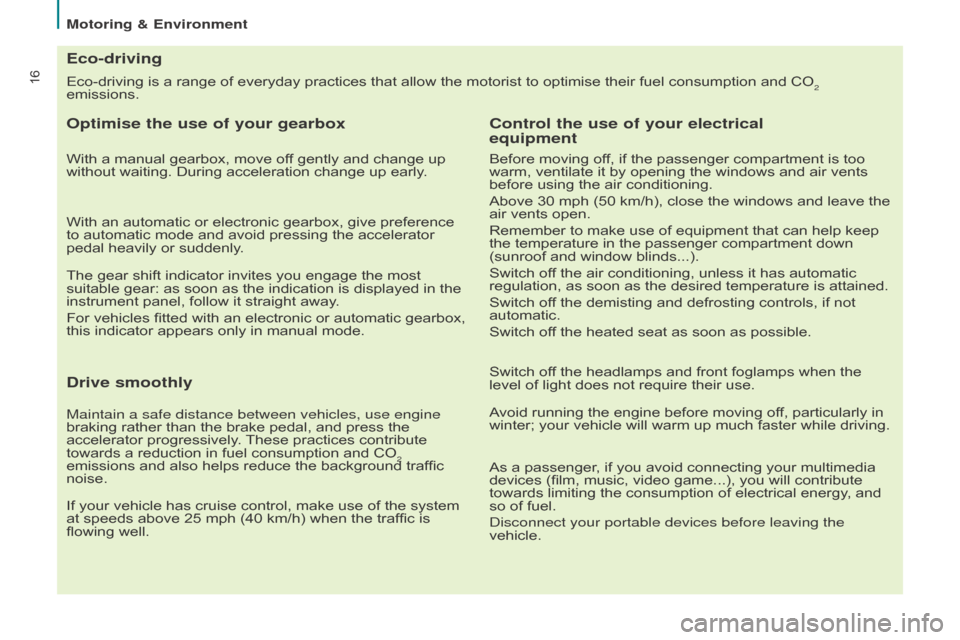
16
Berlingo-2-VP_en_Chap02_eco-conduite_ed01-2015
Eco-driving is a range of everyday practices that allow the motorist to optimise their fuel consumption and CO2
emissions.
Eco-driving
Optimise the use of your gearbox
With a manual gearbox, move off gently and change up without waiting. During acceleration change up early.
With
an automatic or electronic gearbox, give preference
to
automatic mode and avoid pressing the accelerator
pedal
heavily or suddenly.
The
gear shift indicator invites you engage the most
suitable
gear: as soon as the indication is displayed in the
instrument
panel, follow it straight away.
For
vehicles fitted with an electronic or automatic gearbox,
this
indicator appears only in manual mode.
Drive smoothly
Maintain a safe distance between vehicles, use engine
braking rather than the brake pedal, and press the
accelerator
progressively.
These
practices contribute
towards
a reduction in fuel consumption and CO
2
emissions
and
also
helps
reduce
the
background traffic
noise.
If
your
vehicle
has
cruise
control,
make
use
of
the system
at
speeds
above
25
mph
(40
km/h)
when
the
traffic is
flowing
well.
Control the use of your electrical
equipment
Before moving off, if the passenger compartment is too warm, ventilate it by opening the windows and air vents
before
using the air conditioning.
Above
30 mph (50 km/h), close the windows and leave the
air
vents open.
Remember
to make use of equipment that can help keep
the
temperature in the passenger compartment down
(sunroof
and window blinds...).
Switch
off the air conditioning, unless it has automatic
regulation,
as soon as the desired temperature is attained.
Switch
off the demisting and defrosting controls, if not
automatic.
Switch
off the heated seat as soon as possible.
Switch
off the headlamps and front foglamps when the
level
of light does not require their use.
Avoid
running the engine before moving off, particularly in
winter;
your vehicle will warm up much faster while driving.
As
a passenger, if you avoid connecting your multimedia
devices
(film, music, video game...), you will contribute
towards
limiting the consumption of electrical energy, and
so
of fuel.
d
isconnect your portable devices before leaving the
vehicle.
Motoring & Environment
Page 19 of 298
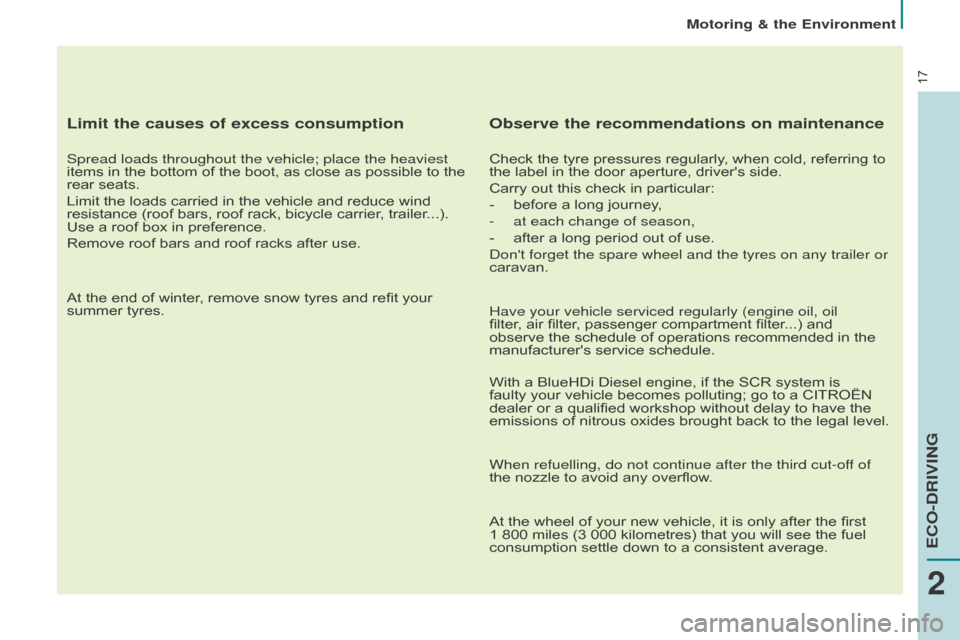
17
Berlingo-2-VP_en_Chap02_eco-conduite_ed01-2015
Limit the causes of excess consumption
Spread loads throughout the vehicle; place the heaviest
items in the bottom of the boot, as close as possible to the
rear
seats.
Limit
the loads carried in the vehicle and reduce wind
resistance
(roof bars, roof rack, bicycle carrier, trailer...).
Use
a roof box in preference.
Remove
roof bars and roof racks after use.
At
the end of winter, remove snow tyres and refit your
summer
tyres.
Observe the recommendations on maintenance
Check the tyre pressures regularly, when cold, referring to the label in the door aperture, driver's side.
Carry
out this check in particular:
-
before
a long journey,
-
at each change of season,
-
after
a long period out of use.
d
on't forget the spare wheel and the tyres on any trailer or
caravan.
Have your vehicle serviced regularly (engine oil, oil
filter,
air filter, passenger compartment filter...) and
observe
the schedule of operations recommended in the
manufacturer's
service schedule.
With
a BlueHDi Diesel engine, if the SCR system is
faulty
your vehicle becomes polluting; go to a CITROËN
dealer
or a qualified workshop without delay to have the
emissions
of nitrous oxides brought back to the legal level.
When refuelling, do not continue after the third cut-off of
the
nozzle to avoid any overflow.
At
the wheel of your new vehicle, it is only after the first
1
800 miles (3 000 kilometres) that you will see the fuel
consumption
settle down to a consistent average.
2
ECo-dRIVInG
Motoring & the Environment
Page 36 of 298
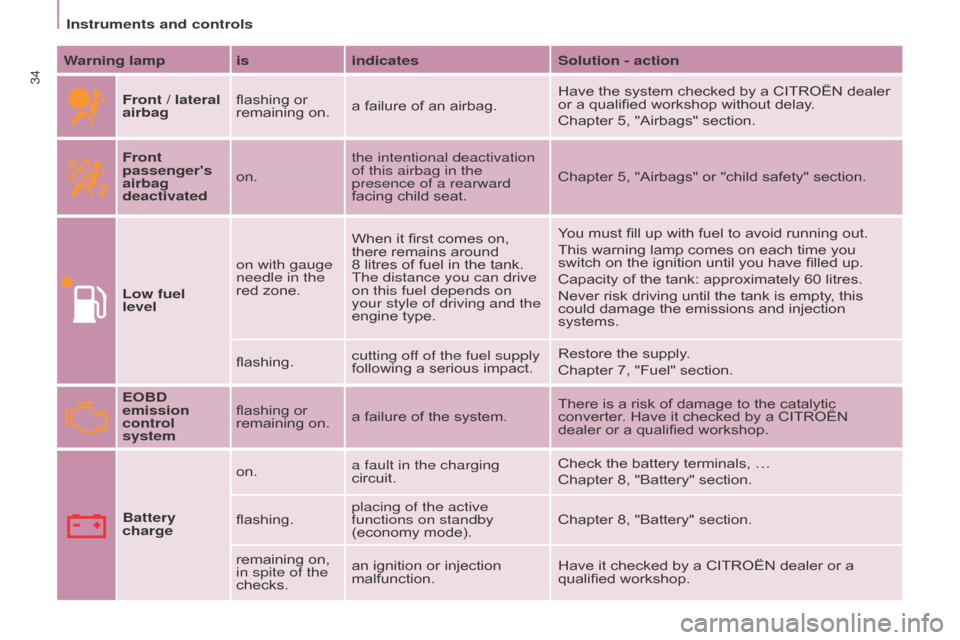
Berlingo-2-VP_en_Chap03_Pret-a-partir_ed01-2015
34
Warning lamp isindicatesSolution - action
Front / lateral
airbag flashing
or
remaining
on.a
failure of an airbag.Have
the system checked by a CITROËN dealer
or
a qualified workshop without delay.
Chapter
5, "Airbags" section.
Front
passenger's
airbag
deactivated on. the intentional deactivation
of this airbag in the
presence of a rearward
facing
child seat.Chapter
5, "Airbags" or "child safety" section.
Low fuel
level on with gauge
needle in the
red
zone.When
it first comes on,
there
remains around
8 litres
of fuel in the tank.
The distance you can drive
on this fuel depends on
your style of driving and the
engine
type.You
must fill up with fuel to avoid running out.
This
warning lamp comes on each time you
switch
on the ignition until you have filled up.
Capacity
of the tank: approximately 60 litres.
Never
risk driving until the tank is empty, this
could
damage the emissions and injection
systems.
flashing. cutting of
f of the fuel supply
following
a serious impact.Restore
the supply.
Chapter
7, "Fuel" section.
EOBD
emission
control
system flashing
or
remaining
on.a
failure of the system.There
is a risk of damage to the catalytic
converter
. Have it checked by a CITROËN
dealer
or a qualified workshop.
Battery
charge on.
a fault in the charging
circuit. Check
the battery terminals, …
Chapter
8, "Battery" section.
flashing. placing of the active
functions on standby
(economy
mode).Chapter
8, "Battery" section.
remaining
on,
in spite of the
checks.an
ignition or injection
malfunction.Have
it checked by a CITROËN dealer or a
qualified
workshop.
Instruments and controls
Page 44 of 298
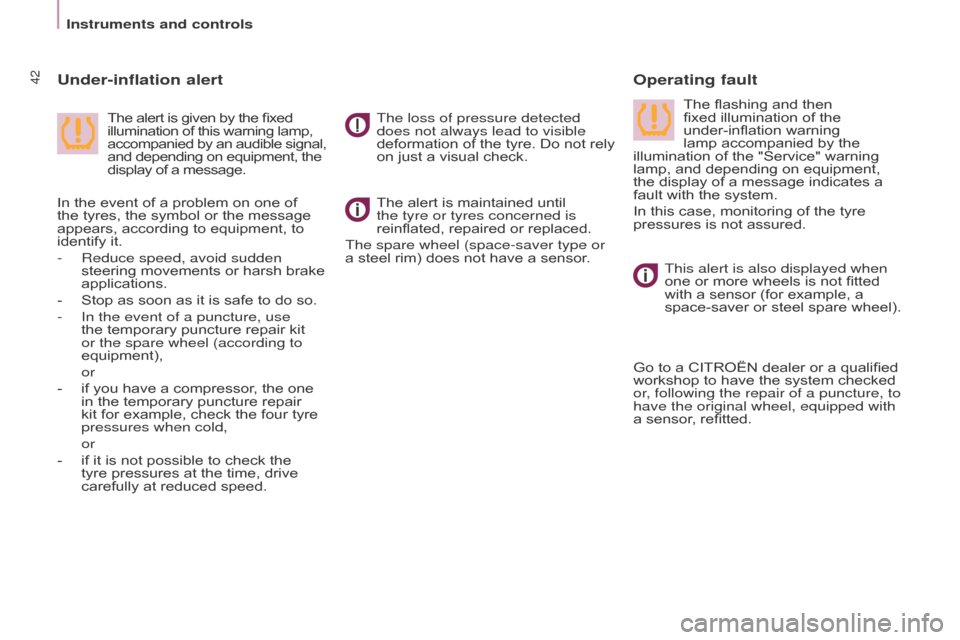
Berlingo-2-VP_en_Chap03_Pret-a-partir_ed01-2015
42
The alert is maintained until the tyre or tyres concerned is
reinflated, repaired or replaced.
The spare wheel (space-saver type or
a
steel rim) does not have a sensor.
Operating fault
Under-inflation alert
The loss of pressure detected
does not always lead to visible
deformation
of
the
tyre.
Do
not
rely
on
just a visual check.
The
alert
is
given
by
the
fixed illumination
of
this
warning
lamp, accompanied
by
an
audible
signal, and
depending
on
equipment,
the
display
of
a
message. The
flashing and then fixed
illumination of the under-inflation
warning
lamp
accompanied by the
illu
mination of the "Service" warning
lamp,
and depending on equipment,
the
display of a message indicates a
fault
with the system.
In
this case, monitoring of the tyre
pressures
is not assured.
In
the
event
of
a
problem
on
one
of
the
tyres,
the
symbol
or
the
message
appears,
according
to
equipment,
to
identify
it.
-
Reduce speed, avoid sudden
steering
movements
or
harsh
brake
applications.
-
Stop
as
soon
as
it
is
safe
to
do
so.
-
In the event of a puncture, use
the
temporary
puncture
repair
kit
or the spare wheel (according to
equipment),
or
-
if
you
have
a
compressor,
the
one
in
the
temporary
puncture
repair
kit
for
example,
check
the
four
tyre
pressures when cold,
or
-
if
it
is
not
possible
to
check
the
tyre
pressures
at
the
time,
drive
carefully
at
reduced
speed.
This alert is also displayed when
one
or more wheels is not fitted
with
a sensor (for example, a
space-saver
or steel spare wheel).
Go
to a CITROËN dealer or a qualified
workshop to
have the system checked
or
, following the repair of a puncture, to
have the original wheel, equipped with
a
sensor, refitted.
Instruments and controls
Page 69 of 298
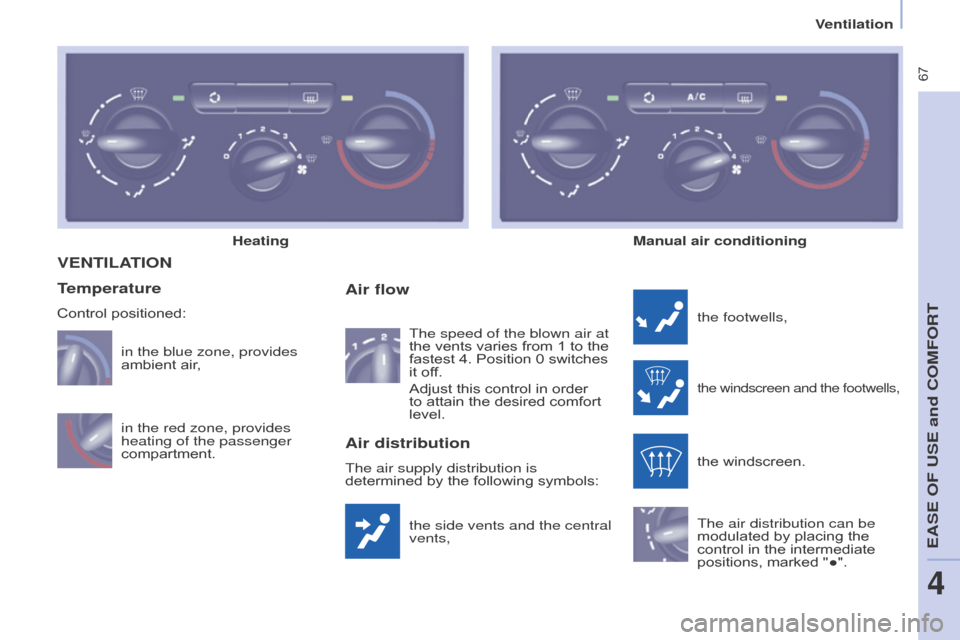
67
Berlingo-2-VP_en_Chap04_Ergonomie_ed01-2015Berlingo-2-VP_en_Chap04_Ergonomie_ed01-2015
VENTILATION
the side vents and the central
vents,
Air flow
the footwells,
the windscreen and the footwells,
the windscreen.
The air distribution can be
modulated
by placing the
control
in the intermediate
positions,
marked "●".
Air distribution
The air supply distribution is
determined by the following symbols:
in the red zone, provides
heating of the passenger
compartment. in the blue zone, provides
ambient
air,
The speed of the blown air at
the vents varies from 1 to the
fastest
4. Position 0 switches
it
off.
Adjust this control in order
to
attain the desired comfort
level.
Heating
Manual air conditioning
Temperature
Control positioned:
EASE OF USE and COMFORT
4
Ventilation
Page 70 of 298
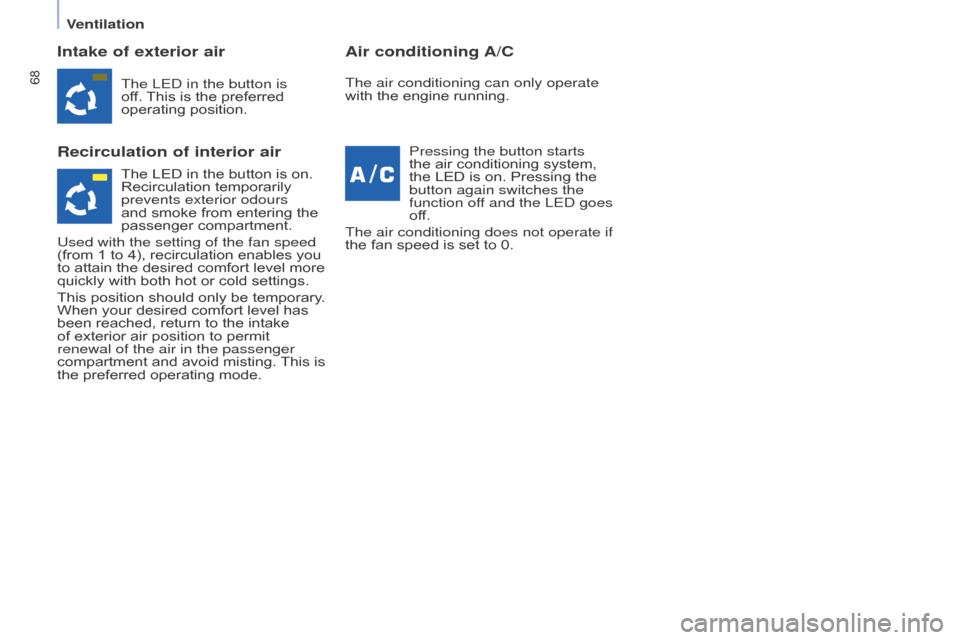
68
Berlingo-2-VP_en_Chap04_Ergonomie_ed01-2015Berlingo-2-VP_en_Chap04_Ergonomie_ed01-2015
Intake of exterior air
Recirculation of interior airAir conditioning A/C
The LEd in the button is
of f. This is the preferred
operating
position.
Pressing the button starts
the
air conditioning system,
the
LED is on. Pressing the
button again switches the
function of
f and the LE d goes
off.
The air conditioning does not operate if
the
fan speed is set to 0.
The air conditioning can only operate
with
the engine running.
The
LED in the button is on.
Recirculation
temporarily
prevents exterior odours
and
smoke from entering the
passenger
compartment.
Used with the setting of the fan speed
(from
1
to 4), recirculation enables you
to
attain
the desired comfort level more
quickly
with both hot or cold settings.
This
position should only be temporary.
When
your desired comfort level has
been
reached, return to the intake
of
exterior air position to permit
renewal of the air in the passenger
compartment
and avoid misting.
This
is
the
preferred operating mode.
Ventilation
Page 71 of 298
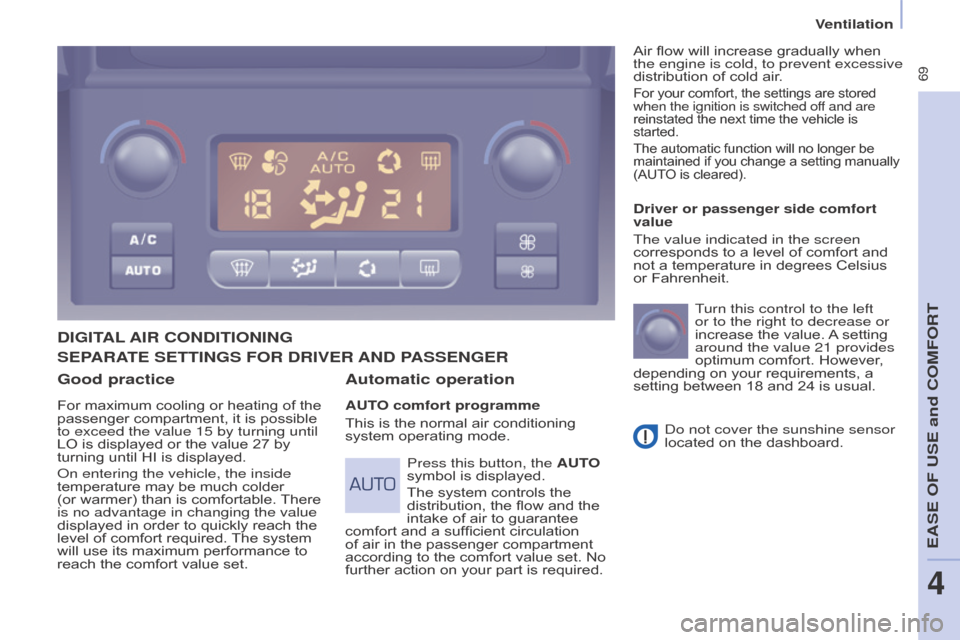
69
Berlingo-2-VP_en_Chap04_Ergonomie_ed01-2015Berlingo-2-VP_en_Chap04_Ergonomie_ed01-2015
Good practice
For maximum cooling or heating of the passenger compartment, it is possible
to exceed the value 15 by turning until
LO
is displayed or the value 27 by
turning
until HI is displayed.
o
n entering the vehicle, the inside
temperature
may be much colder
(or
warmer) than is comfortable.
There
is no advantage in changing the value
displayed
in order to quickly reach the
level
of comfort required.
The
system
will
use its maximum performance to
reach
the comfort value set.
DIGITAL AIR CONDITIONING
Automatic operation
AUTO comfort programme
This
is the normal air conditioning
system
operating mode. Driver or passenger side comfort
value
The value indicated in the screen
corresponds
to a level of comfort and
not
a temperature in degrees Celsius
or
Fahrenheit.
Turn this control to the left
or to the right to decrease or
increase the value.
A
setting
around the value 21 provides
optimum
comfort. However,
depending
on your requirements, a
setting
between 18 and 24 is usual.
d
o not cover the sunshine sensor
located
on the dashboard.
Press this button, the AUTO
symbol
is displayed.
The
system controls the
distribution,
the flow and the
intake
of air to guarantee
comfort
and a sufficient circulation
of
air in the passenger compartment
according
to the comfort value set. No
further
action on your part is required.Air
flow will increase gradually when
the
engine is cold, to prevent excessive
distribution of cold air.
For your comfort, the settings are stored when the ignition is switched of
f and are
reinstated
the next time the vehicle is
started.
The
automatic function will no longer be
maintained
if you change a setting manually
(AUT
O is cleared).
SEPARATE SETTINGS FOR DRIVER AND PASSENGER
EASE OF USE and COMFORT
4
Ventilation
Page 72 of 298
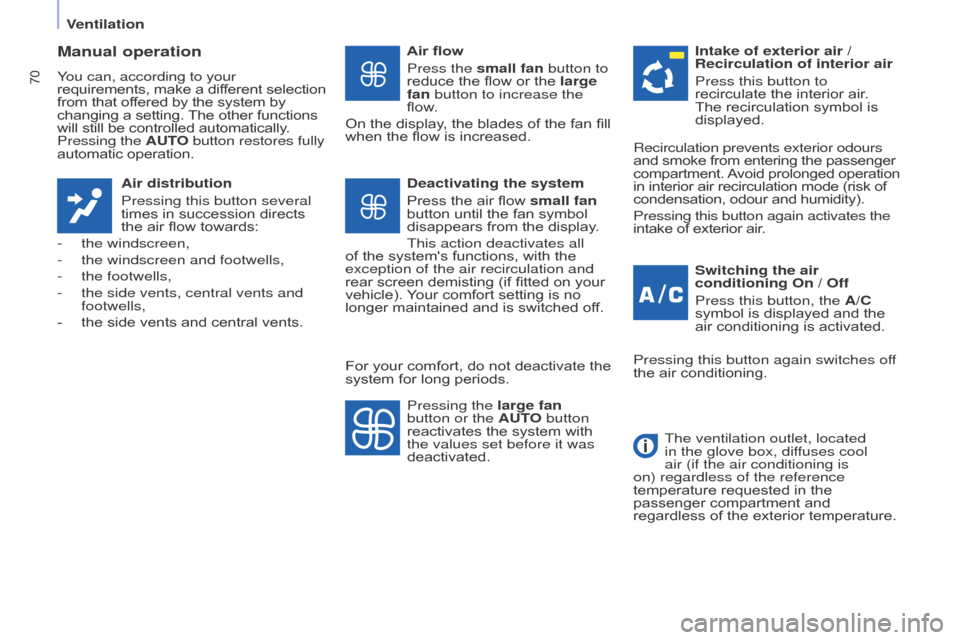
70
Berlingo-2-VP_en_Chap04_Ergonomie_ed01-2015Berlingo-2-VP_en_Chap04_Ergonomie_ed01-2015
Manual operation
You can, according to your
requirements, make a different selection from
that offered by the system by
changing
a setting.
The
other functions
will
still be controlled automatically.
Pressing the
AUTO button restores fully
automatic
operation.
Air distribution
Pressing this button several
times
in succession directs
the
air flow towards:
-
the windscreen,
-
the windscreen and footwells,
-
the footwells,
-
the side vents, central vents and
footwells,
-
the
side vents and central vents.Air flow
Press the small fan button to
reduce
the flow or the large
fan button to increase the
flow.
On
the display, the blades of the fan fill
when
the flow is increased.
Switching the air
conditioning On / Off
Press this button, the A/C
symbol
is displayed and the
air
conditioning is activated.
Deactivating the system
Press
the air flow small fan
button
until the fan symbol
disappears
from the display.
This action deactivates all
of
the system's functions, with the
exception of the air recirculation and
rear
screen demisting (if fitted on your
vehicle).
Y
our comfort setting is no
longer
maintained and is switched off.Intake of exterior air /
Recirculation of interior air
Press this button to
recirculate
the interior air.
The
recirculation symbol is
displayed.
Pressing the
large fan
button or the AUTO button
reactivates
the system with
the values set before it was
deactivated.Recirculation prevents exterior odours
and
smoke from entering the passenger
compartment.
A
void prolonged operation
in
interior air recirculation mode (risk of
condensation,
odour and humidity).
Pressing this button again activates the
intake
of exterior air.
Pressing this button again switches off
the
air conditioning.
The ventilation outlet, located
in the glove box, diffuses cool
air (if the air conditioning is
on) regardless of the reference
temperature
requested in the
passenger
compartment and
regardless
of the exterior temperature.
For
your comfort, do not deactivate the
system
for long periods.
Ventilation
Page 73 of 298
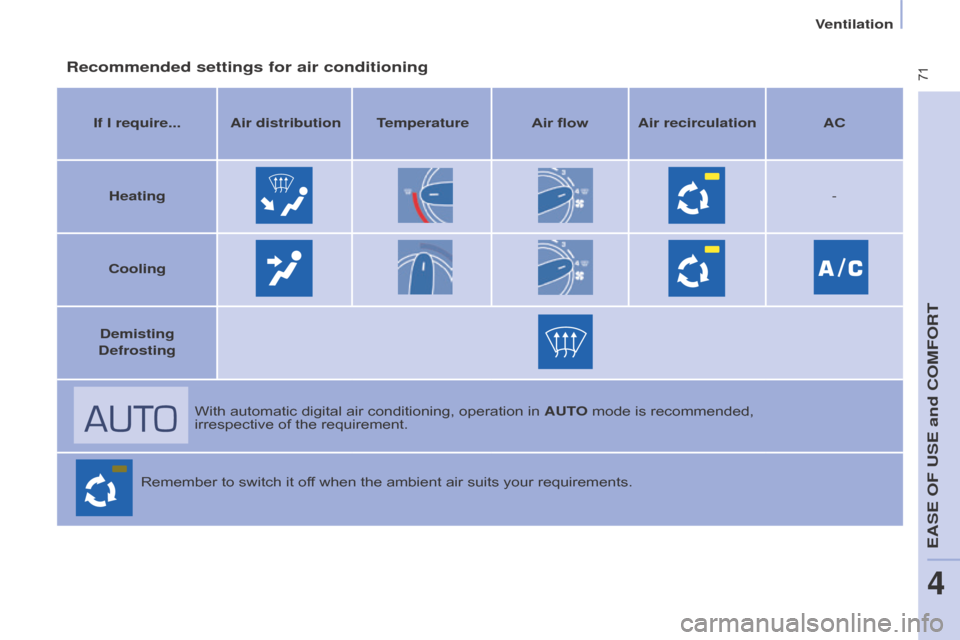
71
Berlingo-2-VP_en_Chap04_Ergonomie_ed01-2015Berlingo-2-VP_en_Chap04_Ergonomie_ed01-2015
Recommended settings for air conditioning
If I require... Air distribution TemperatureAir flowAir recirculation AC
Heating -
Cooling
Demisting
Defrosting
With
automatic digital air conditioning, operation in AUTO mode is recommended,
irrespective
of the requirement.
Remember
to switch it off when the ambient air suits your requirements.
EASE OF USE and COMFORT
4
Ventilation